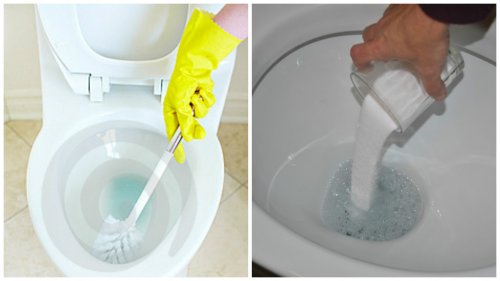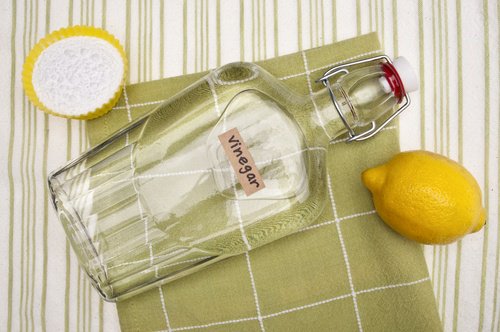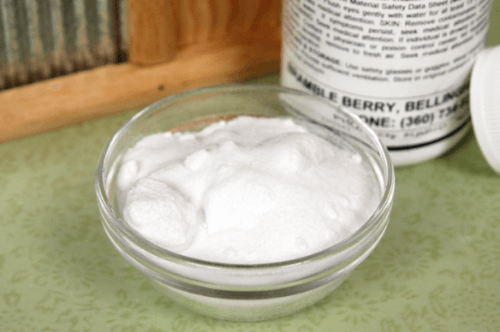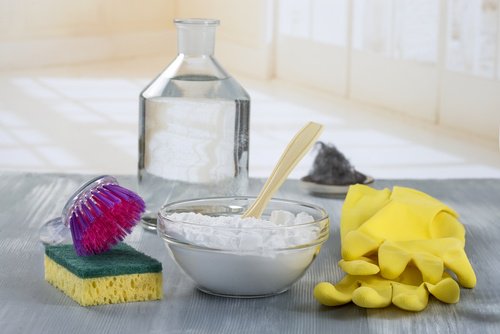Five Tips to Efficiently Remove Limescale from the Toilet

You can also use products such as baking soda in addition to the usual products (bleach, ammonia, and special bathroom cleaning products) to efficiently remove limescale from the toilet.
Due to the fact that it’s important to keep toilets clean so as to avoid bad odors and health problems related to poor cleaning, below, we share a few tips for keeping your toilet clean.
When a toilet isn’t clean, it has a yellow or brown coloring. It could even have limescale. This is caused by the accumulation of calcium and other minerals found in the water supply, as well as bacteria and germs.
Solutions to efficiently remove limescale from the toilet
You can do so with the following mixtures.
1. White vinegar and lemon

The combination of white vinegar with lemon is an excellent natural disinfectant. For decades, it’s been an ecological way of keeping many surfaces clean.
In this particular case, it’s quite useful, since the natural acids of both ingredients easily break down the limescale. Its application significantly reduces the appearance of stains. Incidentally, it also removes the microorganisms that cause unpleasant odors.
Ingredients
- ½ c. of white vinegar
- The juice of one lemon
Instructions
- First of all, add the juice of one lemon into half a cup of white vinegar and vigorously scrub the areas you’re trying to clean with the mixture
- You can use an abrasive sponge or wet sandpaper to make things easier depending on the type of stain
Read more: Simple, Natural Trick to Eliminate Drain and Pipe Odor
2. Cola and baking soda
It’s quite likely that you’ve seen the trick of using cola as an option for unclogging toilets and drains. What you might not know, however, is that you can combine it with other products to remove toilet limescale and stains.
Ingredients
- 1 can of Coke
- 1 c. of white vinegar
- 3 tbsp of baking soda
Instructions
- To clean your toilet, first, pour the Coke all over the limescale
- Let it work for 30 minutes and then scrub it
- Add the white vinegar and baking soda for a sparkling effect afterward
- Let it do its thing for 15 minutes; then, scrub the areas with a brush and rinse
3. Borax can efficiently remove limescale

Regarded as an excellent cleaning agent, borax is a useful substance to disinfect and whiten household toilets and remove toilet limescale.
Although it’s slightly more aggressive than the previous suggestions, it doesn’t cause any negative impact on the environment. In addition, it doesn’t leave volatile compounds that could be harmful to your health.
Ingredients
- 1 c. of white vinegar
- 4 tbsp of Borax powder
- 2 quarts of hot water
Instructions
- First of all, spray white vinegar on the toilet surface and leave it for 20 minutes
- Then, scrub it with a brush, and add the borax powder afterward
- Be sure to wear gloves and a mask when handling these substances in order to prevent skin burns
- Add the hot water after 15 minutes and then, remove the stains with a sponge
4. Baking soda with hydrogen peroxide

A paste made with baking soda and hydrogen peroxide can be very useful for removing toilet limescale.
Both ingredients can naturally clean surfaces and also act as a disinfectant for thorough cleaning.
Ingredients
- 1/2 c. of baking soda
- 2 tbsp of hydrogen peroxide
- The juice of a lemon (optional)
Instructions
- First of all, moisten the baking soda with hydrogen peroxide and use the resulting paste to clean stains from the toilet
- Then, wipe with a cloth or abrasive sponge and allow it to sit for 20 minutes before rinsing
- Optionally, add some lemon juice to achieve a stronger bleaching effect
5. Baking soda and ammonia
Instead of using water, mix the baking soda with ammonia (the content of a cap diluted in one quart of water, approximately) and proceed to remove the limescale with a brush.
You should be able to remove the limescale from the toilet in a short time with this mixture and also, whiten any areas where there’s accumulated dirt.
Other tips on how to efficiently remove limescale from the toilet
When it comes to cleaning the bathroom and, in particular, removing scale from the toilet, it’s important to avoid certain mixtures as they’re highly toxic. Bleach and ammonia, for example.
Choose any of the options listed above (but only one, don’t mix several options at once) and start having a clean bathroom if you haven’t already removed the limescale from your toilet.
Finally, always wear gloves to protect your skin when cleaning your home. In addition, wear a safety mask if you’re going to use bleach or ammonia.
All cited sources were thoroughly reviewed by our team to ensure their quality, reliability, currency, and validity. The bibliography of this article was considered reliable and of academic or scientific accuracy.
- Fedoruk MJ, Bronstein R, Kerger BD. Ammonia exposure and hazard assessment for selected household cleaning product uses. J Expo Anal Environ Epidemiol. 2005 Nov;15(6):534-44.
- Fraise AP, Wilkinson MA, Bradley CR, Oppenheim B, Moiemen N. The antibacterial activity and stability of acetic acid. J Hosp Infect. 2013 Aug;84(4):329-31.
- Guillén Cabrera, F. Traslado de técnicas y tecnologías de joyería cuencana para la aplicación y adaptación en Accesorios de mujer. Universidad del Azuay. 2014. https://dspace.uazuay.edu.ec/handle/datos/3902
- Hadrup N, Frederiksen M, Sharma AK. Toxicity of boric acid, borax and other boron containing compounds: A review. Regul Toxicol Pharmacol. 2021 Apr;121:104873.
- Hita, J. M. P. Limpieza del mobiliario interior. SSCM0108. IC Editorial. 2021.
- Lombeida, U., & Andrés, C. Propuesta para la fabricación y comercialización de un desinfectante que no posea químicos, a base de vinagre de manzana, bicarbonato y limón en la ciudad de Guayaquil. Universidad Católica de Santiago de Guayaquil. 2019. http://repositorio.ucsg.edu.ec/handle/3317/13440
- Vilas Eiroa, P. Ecologistas en acción. Azulejo para el aula de español. 2011. Retrieved from https://redined.educacion.gob.es/xmlui/handle/11162/168177
This text is provided for informational purposes only and does not replace consultation with a professional. If in doubt, consult your specialist.








